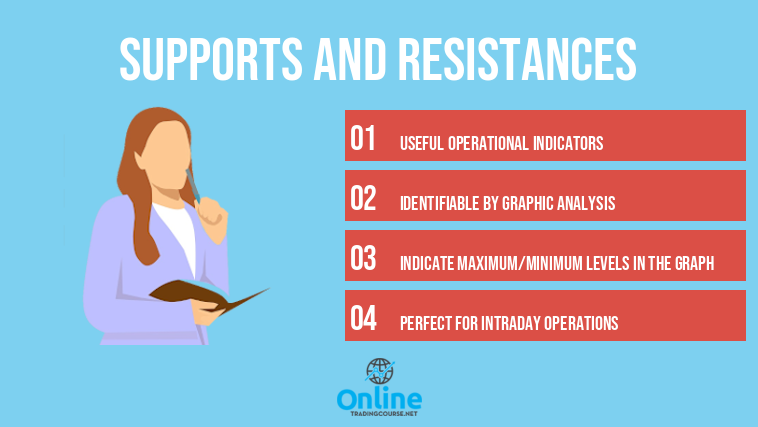
Support and Resistance
Together with Fundamental Analysis, Technical Analysis is the most important type of approach to financial investments. The topic of today, Support and Resistance, is part of this analysis, which origins go back a long time. It was early 1900s when Charles Dow laid the foundations of the discipline by developing his theory.
From that original theory, technical analysis was born and the use of technical indicators has spread, including the one we are talking about today: Support and Resistance. Dow’s theory already contained all the elements that still characterize market analysis today.
Among the timeless teachings of Dow, we have the identification of market trends, but also the idea that prices discount everything. In other words, Dow was the first to say that all the relevant information on the security in question, is then expressed in the price trend.
Dow also taught us that “history repeats itself”, which means that it is possible to predict the trend of the prices of a security by studying its past and revealing its cyclical aspects. In this guide, we are going to discover “supports and resistances” which are an exceptional analysis tool, able to say a lot about the market trend.
Before starting, it is essential to point put that beginners of online trading have the opportunity to copy, completely free of charge, what the best online trading professionals do.
How? Thanks to the eToro trading platform, that has developed an innovative software that allows you to identify the best traders in the world (maximum profit, minimum risk) and copy them automatically.
A beginner who uses eToro has the opportunity to immediately get the same results as the best traders in the world.
You can sign up for free on eToro by clicking here.
To learn more, you can read our full eToro review.
Index
What is Support and Resistance?
Actually, anyone who ever read a trading book knows perfectly well what they are: Supports and Resistances are among the main indicators of graphic analysis, or a fundamental branch of technical analysis. Graphic analysis consists in the search for particular shapes, called by expert “graphic structures”. These are configurations and figures that, if read correctly, help predict price trends.
But, what definition can we give of Support and Resistance?
- Support is defined as a certain price level or market share, where a downward price trend stops.
- Resistance is a certain price level or market share, where the upward price trend freezes.

The basis of the formation of a Support or Resistance can be the most varied market factor. In principle, the factor to consider most is the concentration of Buy or Sell around a specific price area. But what does it mean?
When a Support is formed, it is the concentration of purchases that manages to block a further drop in prices. In other words, whenever the price approaches Support, buyers acquire greater strength on the market, preventing the price from falling below a certain quota.
When a Resistance is formed, however, it is the concentration of the sales that prevents the price from rising further. In this case, when the price approaches the Resistance, many sellers participate in the market and thus manage to prevent the price from continuing to rise towards higher shares.
Support and Resistance: are they reliable?
The discussion on the reliability of the signals, coming from graphic and technical indicators, is always very delicate, signals are the preferred of investors. It is on the basis of these that decisions are made on how and when to invest on a specific security under consideration.
For this reason, it is legitimate to ask if supports and resistances are reliable. Like any other indicator, it must be said that the answer is “it depends”. Both the supports and the resistances are very reliable, the “attacks” they have been able to resist are greater than other indicators.
To put it simply, whenever a Support or Resistance level is tested by the price, without a break occurring, that specific price level is strengthened and becomes more difficult to overcome and therefore more reliable for investors.
So, as long as a Support manages to prevent a downward breach it will continue to be respected and carefully studied by traders. Likewise, when a Resistance manages to push the price down 2 or more times without breaking, it must always be taken into consideration.
When and why these breaks occur?
The “breaking” of a Support or Resistance (called in technical jargon “breakout”) is the phenomenon that determines the definitive overcoming of the previous price level. This is a very important bullish or bearish trading signal as appropriate.
Penetrating or breaking a Support or Resistance level can have many causes:
- Strong positive events: in the case of corporate securities, but also on generic markets, when a very positive event occurs, a break in Resistance may occur. The positive news can finally push the price upwards, because the buyers go into the market en masse and the strong demand on the stock tends to raise prices without taking into account the Resistance, which will eventually break.
- Strong negative events: in the same way, when negative events and news hit a stock or other market, the market will soon react with mass sales and this leads to the breakout of the Support that previously kept the price afloat. This is a rather reliable bearish signal which has repercussions on the market, probably generating a new trend.
- Market emotion: it is not always the law of supply and demand that triggers markets in one sense or another. Sometimes the emotional factor is enough to determine the formation of a support or resistance, but also their breakout. A classic example of how important market emotionally is, are round figures, such as the share 100, 1000 or 10000 of a price.
- Simple forecast: other times, even simple forecast on price trends, in recent times, are enough to determine the breakout of a support or resistance.
Understand and interpret the indicator
Before using Support and Resistances during the investment phase, it is essential to understand well why they behave in this way and what information they offer us on price trends. Not everything that happens on a market can be read in this price graph, but it is thanks to indicators like this that more operational indications are obtained and wise decisions can be made in investments.
Based on what has been said so far, it is clear that the indicator addressed here is capable of showing, with great simplicity, the power of the two main market forces: supply and demand.
As we have already mentioned, if there is a breakout above a resistance level, it is clear that an increase in demand has occurred. Many more buyers are willing to buy at higher prices than even before.
When the breakout of a support occurs, there is an increase in the strength of the sellers on the market. In this case, it is clear that confidence in the security or currency has been lost and therefore more sellers are willing to sell the asset at lower price than the current one.

The role changes of Support and Resistance
As we have mentioned several times, the decisive and most important moment to observe in the trading phase is that of breakout. When breakages occur, they cause a very particular phenomenon: Supports and Resistances change roles. So:
- When the price exceeds a resistance level, it automatically becomes a support.
- When the price goes above a support level, it automatically becomes a resistance.
So, how to interpret the breakout? When can they be trusted? A breakout is to be considered as such only if, after it has occurred, the price continues its course upwards or downwards. If the market continues to linger near the old level of support or resistance, it means that could be a false signal.

As can be seen from the image above, points 1 and 2 represent the formation of resistance, but, when at the end there is the breakout, represented by the dashed line being crossed by the line representing the price, the same dotted line assumes the supporting role for the new market trend.
Of course, not in all cases the price will test the new level of support several times. If the new bullish trend, that led to the breakout, is strong enough, the price could go even higher before the first serious corrections on the new trend arrive.
However, it often happens that the market continues to consider the previous level of support or resistance important and therefore a pullback may occur. Sellers and buyers tend to place sales and purchase orders at important technical levels and, for this reason, their validity is often reconfirmed.
How to draw the indicator on the graph?
We mentioned that Supports and Resistances are “graphical” indicators, this means that each analyst can draw them by himself directly on the price chart of the asset he chose. This makes the indicator really simple to manage because it is enough to draw a line on the right points to obtain the information by support and resistance.
The lines can be drawn horizontally (in this case we talk about Support or Static Resistance), but also in an oblique direction (here we talk about dynamic indicator). In the first case the price level is a precise and constant point in time, in the second case, instead, we can speak of trend lines that change over the time.

Trade with Support and Resistance
After this overview of what supports and resistances are and how they work, now it’s time to go into more detail about how support and resistances can be used to make market operations. To do this, it is necessary, first of all, to understand what kind of indications these tools can give us.
The analysis of support and resistances is fundamental in the study of market trends. The indicator can be used to study trends and also identify possible price reversals. When operational signals arise thanks to breakouts, it is necessary to be ready and open positions at the right time.
When you do analysis on a certain level of market price and you find very firm support or resistance, then you can think of profiting from this situation in two main ways:
- Wait for the price breakout and the creation of new trend
- Wait for the price rebound and then trading on the pullback
Read also: ADX
Operate at the right distance
It is important to remember that as long as the price of a security remains between the support and resistance levels, the current trend is expected to continue. As we mentioned, breaking a support or resistance does not always generate a new trend.
For less experienced traders, it is not recommended to trade in the support or resistance areas because the volatility of the securities and currencies can skyrocket here. So, even market movements can become unpredictable and difficult to read.
The rule of any investors is to never place orders directly matching a support or resistance level. It is always better to wait for the price to deviate slightly from the risk area before thinking of placing your own on the market.
Always remember: the reliability of the tool is directly proportional to the ability to draw lines on the graph. If the indicator has been well traced, then it is possible to consider the resistance to price attack as a good reliability factor of the signals generated.
The indicator lines must never be forced, we must draw them in the most natural way possible. The historical highs and lows reached by prices are the most reliable general levels for the markets. But in particular situations, even historical levels can be broken.
Operational Tips and Trading Signals
To use supports and resistances effectively, there is no need to make complex mathematical calculations. There is no need to have particular knowledge regarding the markets or technical analysis, just draw the lines on the maximum and minimum levels of the market in the correct way.
If you want to invest with this tool, it is very important to learn how to evaluate the strength of the indicator. Only then you can make good decisions and trade with awareness, here are 3 factors to watch out for:
- Market volume: large market volumes can be concentrated around supports and resistances. This means that there may be many active investors at that time adding liquidity to the market. The higher the volumes, the greater the probability that a support or resistance will break.
- Time factor: time is also an important variable for assessing the strength of a support or resistance. The more time has passed since a certain price level was formed, the more solid and reliable it will be. At the same time, more recent is a level of support or resistance, much less it should be considered reliable.
- Distance from the level: in addition, there is an attraction phenomenon to consider. When the price has not yet gotten far from a support or resistance, many traders tend to retrace their steps trying to bring the price back to its previous levels. The greater the distance from the support or resistance rice share, the greater its reliability.
Read also: MACD
Make Money with Support and Resistance
The goal of those who use supports and resistance is to do market analysis to obtain better performance during the investment phase. For this reason, if you intend to make money with supports and resistances you must use them in your market analysis, but you must also do it with the right financial instruments.
The most recommended tool to use to invest with supports and resistances are CFDs. We are talking about contracts for difference, a powerful investment tool that enables the trader to speculate as much as possible from the price movements that occur on the most varied financial markets.
Thanks to CFDs, and the modern broker platforms for online trading that offer them, trading has become much easier. With CFD you can take advantage od all the market movements that are generated around the levels of support and resistance. It takes just a few clicks to place your market orders and be sure to use the trading signals immediately, as soon as they arise.
What kind of operations can be done with CFDs? Here, in 2 points, how to make market decisions in CFDs based on the indications that come from supports and resistances:
- Long market: if you want to buy, you have to wait for the breakout of a resistance level, which then turns immediately into support. The price will then tend to rise and you can earn until the new trend loses its strength. Then set the order a few Pips above the new support, while the stop loss will be set a few Pips below the new support.
- Short market: in the same way, if the price breaks a support level with a downward decision, resistance is formed. The price, at this point, will most likely continue to fall. Send the sales order a few Pips below the new resistance and set the stop loss a few pips above.
Below, a complete list of the best CFD brokers also available for beginners:

|
Platform: etoro Min. Deposit: 50€ License: Cysec |
|
|
|---|---|---|---|

|
Platform: xtb Min. Deposit: 100€ License: Cysec |
|
|

|
Platform: iqoption Min. Deposit: 50€ License: Cysec |
|
|

|
Platform: ubrokers Min. Deposit: 250€ License: Cysec |
|
|

|
Platform: trade Min. Deposit: 100€ License: Cysec |
|
72.30% of retail CFD accounts lose money
|

|
Platform: forextb Min. Deposit: 250€ License: Cysec |
|
|
Conclusions on Support and Resistance
In this guide, we have seen that Supports and Resistances have great power and are excellent tools for reading the different market situations.
Start practicing this indicator now and find out how drawing simple lines on a graph can change your performance on the financial markets.
These values indicate the level where the price tends to congest, determining minimum (supports) or maximum (resistances) levels.
From the simple graphical analysis it will be possible to identify these levels, observing the closure of the candlesticks. If at least 4 candles close at a specific point, it will be possible to talk about the level of support / resistance.
Very simple, you enter the market if one of these levels breaks, with the Stop Loss just below the support or the resistance just passed.
Surely the Metatrader, also for its ease in tracing operating lines that will become supports or resistances.
